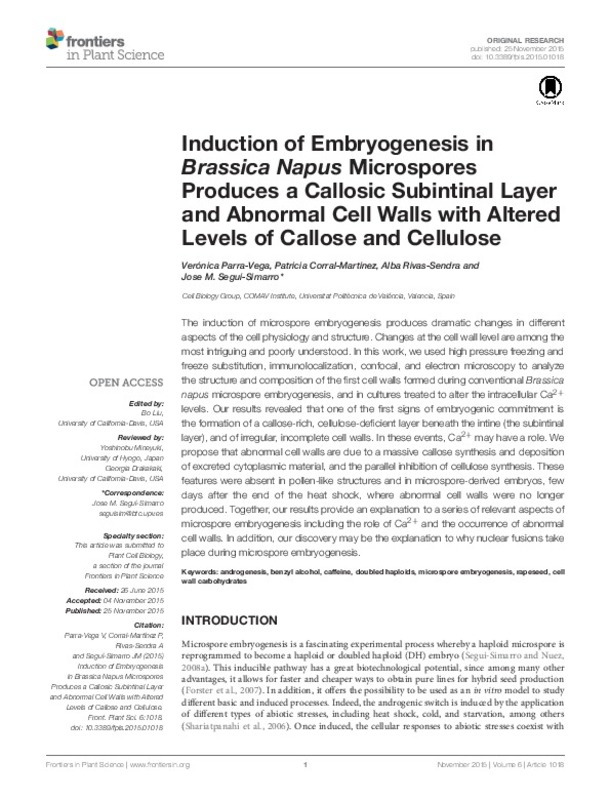JavaScript is disabled for your browser. Some features of this site may not work without it.
Buscar en RiuNet
Listar
Mi cuenta
Estadísticas
Ayuda RiuNet
Admin. UPV
Induction of embryogenesis in Brassica napus microspores produces a callosic subintinal layer and abnormal cell walls with altered levels of callose and cellulose
Mostrar el registro sencillo del ítem
Ficheros en el ítem
| dc.contributor.author | Parra Vega, Verónica
|
es_ES |
| dc.contributor.author | Corral Martínez, Patricia
|
es_ES |
| dc.contributor.author | Rivas-Sendra, Alba
|
es_ES |
| dc.contributor.author | Seguí-Simarro, Jose M.
|
es_ES |
| dc.date.accessioned | 2016-11-09T09:11:51Z | |
| dc.date.available | 2016-11-09T09:11:51Z | |
| dc.date.issued | 2015-11-25 | |
| dc.identifier.issn | 1664-462X | |
| dc.identifier.uri | http://hdl.handle.net/10251/73629 | |
| dc.description | The Supplementary Material for this article can be found online at: http://journal.frontiersin.org/article/10.3389/fpls.2015.01018 | es_ES |
| dc.description.abstract | The induction of microspore embryogenesis produces dramatic changes in different aspects of the cell physiology and structure. Changes at the cell wall level are among the most intriguing and poorly understood. In this work, we used high pressure freezing and freeze substitution, immunolocalization, confocal and electron microscopy to analyze the structure and composition of the first cell walls formed during conventional Brassica napus microspore embryogenesis, and in cultures treated to alter the intracellular Ca2+ levels. Our results revealed that one of the first signs of embryogenic commitment is the formation of a callose-rich, cellulose-deficient layer beneath the intine (the subintinal layer), and of irregular, incomplete cell walls. In these events, Ca2+ may have a role. We propose that abnormal cell walls are due to a massive callose synthesis and deposition of excreted cytoplasmic material, and the parallel inhibition of cellulose synthesis. These features were absent in pollen-like structures and in microspore-derived embryos, few days after the end of the heat shock, where abnormal cell walls were no longer produced. Together, our results provide an explanation to a series of relevant aspects of microspore embryogenesis including the role of Ca2+ and the occurrence of abnormal cell walls. In addition, our discovery may be the explanation to why nuclear fusions take place during microspore embryogenesis. | es_ES |
| dc.description.sponsorship | We want to express our thanks to the staff of the Electron Microscopy Service of Universitat Politecnica de Valencia. Thanks are also due to Dr. Kim Boutilier (PRI Wageningen, The Netherlands) for her help during the stays of VPV and ARS at her lab, to Dr. Samantha Vernhettes (INRA Versailles, France) for her kind gift of S4B staining, and especially to Prof. L. A. Staehelin for his help and friendship during the stay of JMSS at UC Boulder. This work was supported by grants BEST/20081154 from Generalitat Valenciana and AGL2014-55177-R from Spanish MINECO to JMSS. | en_EN |
| dc.language | Inglés | es_ES |
| dc.publisher | Frontiers Media | es_ES |
| dc.relation.ispartof | Frontiers in Plant Science | es_ES |
| dc.rights | Reconocimiento (by) | es_ES |
| dc.subject | Androgenesis | es_ES |
| dc.subject | Benzyl alcohol | es_ES |
| dc.subject | Caffeine | es_ES |
| dc.subject | Doubled haploids | es_ES |
| dc.subject | Microspore embryogenesis | es_ES |
| dc.subject | Rapeseed | es_ES |
| dc.subject | Cell wall carbohydrates. | es_ES |
| dc.subject | Electron Microscopy Service of the UPV | |
| dc.subject.classification | GENETICA | es_ES |
| dc.title | Induction of embryogenesis in Brassica napus microspores produces a callosic subintinal layer and abnormal cell walls with altered levels of callose and cellulose | es_ES |
| dc.type | Artículo | es_ES |
| dc.identifier.doi | 10.3389/fpls.2015.01018 | |
| dc.relation.projectID | info:eu-repo/grantAgreement/GVA//BEST%2F2008%2F154/ | es_ES |
| dc.relation.projectID | info:eu-repo/grantAgreement/MINECO//AGL2014-55177-R/ES/NUEVAS VIAS DE MEJORA DE LA EMBRIOGENESIS DE MICROSPORAS EN SOLANACEAS RECALCITRANTES: ESTUDIO DE LA AUTOFAGIA, LA UPR Y LA REGULACION HORMONAL/ | es_ES |
| dc.rights.accessRights | Abierto | es_ES |
| dc.contributor.affiliation | Universitat Politècnica de València. Departamento de Biotecnología - Departament de Biotecnologia | es_ES |
| dc.contributor.affiliation | Universitat Politècnica de València. Escuela Técnica Superior de Ingeniería Agronómica y del Medio Natural - Escola Tècnica Superior d'Enginyeria Agronòmica i del Medi Natural | es_ES |
| dc.contributor.affiliation | Universitat Politècnica de València. Instituto Universitario de Conservación y Mejora de la Agrodiversidad Valenciana - Institut Universitari de Conservació i Millora de l'Agrodiversitat Valenciana | es_ES |
| dc.description.bibliographicCitation | Parra Vega, V.; Corral Martínez, P.; Rivas-Sendra, A.; Seguí-Simarro, JM. (2015). Induction of embryogenesis in Brassica napus microspores produces a callosic subintinal layer and abnormal cell walls with altered levels of callose and cellulose. Frontiers in Plant Science. 6(1018):1-17. https://doi.org/10.3389/fpls.2015.01018 | es_ES |
| dc.description.accrualMethod | S | es_ES |
| dc.relation.publisherversion | http://dx.doi.org/10.3389/fpls.2015.01018 | es_ES |
| dc.description.upvformatpinicio | 1 | es_ES |
| dc.description.upvformatpfin | 17 | es_ES |
| dc.type.version | info:eu-repo/semantics/publishedVersion | es_ES |
| dc.description.volume | 6 | es_ES |
| dc.description.issue | 1018 | es_ES |
| dc.relation.senia | 296705 | es_ES |
| dc.identifier.pmcid | PMC4658426 | en_EN |
| dc.contributor.funder | Ministerio de Economía y Competitividad | es_ES |
| dc.contributor.funder | Generalitat Valenciana | es_ES |








